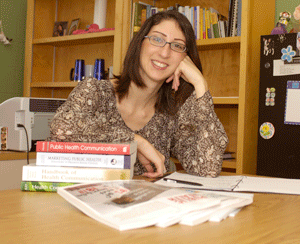Diagnosis ‘Cyberchondria’: Navigating the Changing
Landscape of Health Communication
February 11. 2010

Daniela Friedman
More than half of U.S. adults turn to the Internet to receive their heath information.
Individuals are inundated with approximately 1,500 advertising messages per day from a variety of sources, including billboards both on and offline to television and radio commercials and product placements. A large number of these are health related.
Compound this amalgam of prescription drug, diet, and exercise equipment ads with texting, tweeting, and sharing on social networking, and our exposure and interactions with these messages are increasing exponentially.
With all of these health and medical messages swirling around at top speed, it should not be surprising to learn that “cyberchondria” is on the rise.
“Welcome to Public Health 2.0. Not only are we being constantly overwhelmed with conflicting messages about our health, but we are receiving them through a whole new set of technologies. This may be a blessing and a curse,” said Dr. Daniela Friedman, an assistant professor at the Arnold School of Public Health.
Addressing the winter meeting of the S.C. Public Health Association in Columbia, Friedman said that public health professionals have an opportunity and obligation to help people make sense of the research findings and news that affect their health and lives.
For starters, try Lesson 1: “Keep It Simple.”
That means avoiding the use of jargon, esoteric language spoken by people in specific jobs or groups that is usually used to impress others.
Instead, Friedman stressed the importance of plain language for clear communication in the development of texts that are easy to read, user-friendly, and reader-focused. This should be done regardless of whether a person is communicating through email, a text message, or a health website.
“Speaking clearly doesn’t mean that you’re ‘dumbing down’ the information,” Friedman said. “You’re making it easier for people to understand so they can use it.”
Lesson 2: “Be accurate and consistent.”
The STARCC message principle promoted by Barbara Reynolds of the Centers for Disease Control and Prevention is a fail-proof communications method – Simple, Timely, Accurate, Relevant, Credible and Consistent.
Being credible includes communication that respects all cultures and communities, Friedman said, highlighting a diabetes campaign that featured African-American and Hispanic individuals.
A point that easily exemplifies Lesson 3: “Tailor it please!”
One size does not fit all, Friedman said.
Clear communication involves understanding the demographic and behavioral traits of an intended audience, as well as “psychographic” factors such as people’s values and beliefs about health, where they get their health-related information, and how they spend their time and money.
Effective communication also must recognize that messages and information channels may need to be changed over time – and sometimes quickly. An example is H1N1 education.
Early on, public health workers focused on getting out basic information about H1N1 prevention. Then, information shifted toward the need for vaccinations among children and adults in at-risk groups. As the vaccine became more plentiful, communication focused on expanding this to other groups through multiple media channels.
“Good communication is critical in every facet of society,” Friedman said. “With health and medical news so pervasive, and readily available through a myriad of new channels, it is our job to filter through the information overload and help people understand that information and how it pertains to them, their community, and society.”



_01.jpg)
_02.jpg)